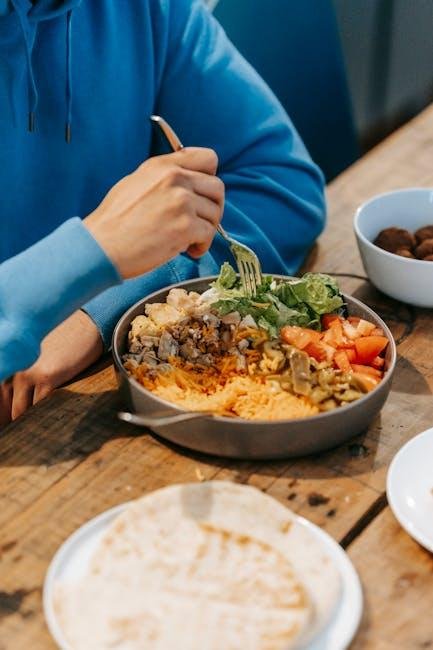In an age where dietary fads come and go like seasons, the concept of creating a balanced plate remains timeless and essential. A well-constructed plate is more than just a feast for the eyes; it’s the foundation of wholesome nutrition and healthy living. But what does it truly mean to build a balanced plate? Is it merely about portion sizes, or does it delve deeper into the colorful array of foods we select? In this article, we’ll explore the art and science of meal composition, equipping you with the knowledge to craft a vibrant, nourishing plate every time. From understanding food groups to practical tips for balanced eating, join us on a journey that transforms the way you view your meals, turning each dining experience into a celebration of health and harmony.
Crafting Your ideal Plate with Colors and Textures
Creating a visually appealing plate can elevate your meal from ordinary to unusual. Colors and textures play a crucial role in this culinary art. To build your ideal plate, begin with a variety of vibrant vegetables such as dark leafy greens, luminous reds of tomatoes, or golden yellows of bell peppers.Incorporate proteins like grilled chicken or marinated tofu that add contrasting shades and textures. Don’t forget to sprinkle in some grains like quinoa or brown rice, which can offer a subtle earthiness to balance the vibrant hues of your other ingredients.
Texture contributes just as considerably to the overall experience of your meal. Aim for a balance of crispy, creamy, and chewy elements to enhance your dish. Consider adding toasted nuts for a crunchy element next to the softness of avocado or hummus. Fresh herbs also add a burst of color and a layer of flavor. Here’s a simple guide to building your balanced plate:
| Component | Examples |
|---|---|
| Protein | Grilled chicken, tofu, beans |
| Vegetables | Spinach, carrots, bell peppers |
| Grains | Brown rice, quinoa, barley |
| Healthy Fats | Avocado, olive oil, nuts |
| herbs/Spices | Basil, cilantro, lemon zest |

Understanding Portion Control for Nutrient Density
Portion control plays a crucial role in achieving a balanced diet that is not only satisfying but also nutrient-dense. Understanding the right amounts helps ensure you’re getting the benefits of various food groups without overindulging. To create a harmonious plate, consider the following guidelines:
- Vegetables: Fill half your plate with a variety of colors to maximize nutrient intake.
- Proteins: Aim for a serving size about the size of your palm, choosing lean sources.
- Grains: Limit grains to a quarter of the plate,opting for whole grains whenever possible.
- healthy Fats: Use fats sparingly; a thumb-sized portion is often enough for flavor and nutrition.
Another essential aspect is recognizing that nutrient density varies across different foods. Focus on foods that provide more nutrients per calorie, which contributes to your overall health. Use the following table as a quick reference to understand how to select nutrient-dense options:
| food Type | Nutrient-Dense Options | Less Nutrient-Dense Options |
|---|---|---|
| Vegetables | Spinach, Kale, Bell Peppers | Lettuce, Potatoes |
| proteins | Chicken Breast, Lentils, Tofu | Processed Meats, High-Fat Cuts |
| Grains | Quinoa, Brown Rice, Oats | White Bread, sugary Granola |
| Fats | Avocados, Olive Oil, Nuts | Butter, Fried Foods |
By mastering portion control, you can create a satisfying plate that not only nourishes your body but also enhances your dining experience.Being mindful about what you put on your plate is a step towards better health and well-being.

Incorporating Proteins, Carbohydrates, and Healthy Fats
Building a balanced plate requires a harmonious blend of proteins, carbohydrates, and healthy fats. Each component plays a crucial role in fueling your body and promoting optimal health. Consider lean meats, legumes, tofu, or Greek yogurt as excellent sources of protein. They not only help in muscle repair but also keep you feeling full longer. For carbohydrates, opt for whole grains, fruits, and vegetables which offer essential nutrients and sustained energy. incorporating colorful produce can elevate your dishes visually and nutritionally, making meals not just healthy but also appealing.
Equally critically important, healthy fats contribute to heart health and improve nutrient absorption. Favor sources such as avocados, nuts, seeds, and olive oil. Including these in moderation can enhance flavor and texture while supporting brain function. When planning your meals, think about combining these elements into satisfying portions. A well-structured plate might look like this:
| Food Group | Examples |
|---|---|
| Proteins | Chicken, Lentils, Quinoa |
| Carbohydrates | Brown Rice, Sweet Potatoes, Spinach |
| Healthy Fats | Almonds, Chia seeds, Coconut Oil |

Building a Balanced Plate for Every Meal of the Day
Creating a balanced plate involves more than just filling your dish with food; it’s about ensuring that each meal provides the right mix of essential nutrients. Start by visualizing your plate divided into sections, ensuring that half is reserved for fruits and vegetables. These vibrant additions not only bring color to your meal but also provide vital vitamins, minerals, and fiber. Aim for a variety of colors and types to maximize nutritional benefits. in the remaining sections, allocate one quarter to lean proteins, such as chicken, tofu, or lentils, which help build and repair tissues, and one quarter to whole grains like brown rice or quinoa, providing lasting energy throughout the day.
Incorporating healthy fats can further enhance your meals, so don’t forget to include a small portion, such as a drizzle of olive oil or a sprinkle of nuts, to round out your plate.whether it’s breakfast, lunch, or dinner, the same principles apply. Such as:
| Meal | Plate Composition |
|---|---|
| Breakfast | ½ Fruits (berries, banana) ¼ Protein (eggs, yogurt) ¼ whole Grains (oats, whole grain toast) |
| Lunch | ½ Vegetables (mixed salad, steamed broccoli) ¼ Protein (grilled chicken, chickpeas) ¼ Whole Grains (quinoa, brown rice) |
| Dinner | ½ Vegetables (roasted vegetables, stir-fry) ¼ Protein (fish, beef) ¼ Whole Grains (barley, whole wheat pasta) |
By consistently applying these principles, you’ll not only enhance the palatability of your meals but also ensure that each bite contributes to your overall health. Be flexible with your choices, allowing yourself the freedom to experiment with different foods, flavors, and textures while maintaining balance and nutrition in mind.
Key Takeaways
mastering the art of building a balanced plate is not just about nutrition; it’s about creating a harmonious relationship with food that supports your well-being and delights your senses. By incorporating a variety of food groups and paying attention to portions, you can enjoy meals that are as visually appealing as they are satisfying. Remember, balance doesn’t have to be boring—get creative with flavors, colors, and textures to keep your meals exciting. As you embark on this journey towards mindful eating, let your plate be a canvas, inviting you to explore the delicious possibilities that nourish both body and spirit.So, the next time you sit down to eat, take a moment to appreciate the balance you’ve created and savor the journey to a healthier you, one bite at a time.




